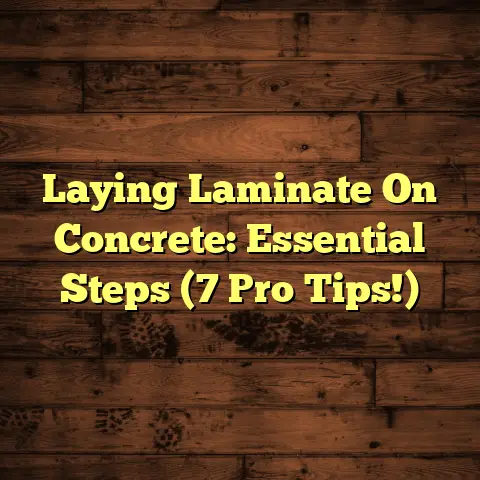Can You Put Radiant Heat Under Laminate Flooring? (Explained)
“Radiant heating is the best way to keep your home cozy, especially under laminate flooring,” said an expert I once spoke with at a trade show.
This statement stuck with me because it perfectly captures the allure of combining modern heating solutions with stylish flooring options.
When I first started as a flooring contractor, I encountered many homeowners curious about radiant heat beneath laminate flooring.
It’s a hot topic—pun intended.
Many people love the look and feel of laminate but wonder if they can enjoy the warmth of radiant heat without compromising the integrity of their floors.
After years of experience in the industry, I have gathered insights that can help answer this question.
The Basics of Radiant Heat and Laminate Flooring
Radiant heating systems are designed to warm up a space by heating the surfaces within it.
This means that instead of relying on air circulation, heat rises directly from the floor.
Laminate flooring, on the other hand, is a popular choice due to its affordability and versatility.
But can these two coexist?
My First Experience
I remember a project in a cozy home in the suburbs where the homeowner specifically wanted radiant heat under their new laminate floors.
It was a beautiful space, and they were excited to enhance their comfort levels during winter.
I had previously installed radiant heating under tile and hardwood but was unsure how it would perform under laminate.
After some research and discussions with suppliers, I learned that radiant heating can be effectively used with laminate flooring, provided certain conditions are met.
The key is to ensure that the laminate is rated for use with radiant heat.
Not all laminates are created equal; some can warp or buckle when exposed to high temperatures.
Choosing the Right Laminate
Selecting the right laminate is crucial for a successful installation.
I often advise my clients to look for products labeled as “radiant heat compatible.” These laminates are designed to withstand the heat without compromising their structure or appearance.
Thickness Matters
The thickness of the laminate can also play a role.
Thicker laminates generally have better thermal conductivity, which means they can distribute heat more evenly across the floor.
During that project in the suburbs, we opted for a 12mm thick laminate.
Not only did it look great, but it also performed well with the radiant heating system.
Brands to Consider
Over the years, I have worked with various brands that offer radiant heat-compatible laminate.
Some of my favorites include:
- Pergo: Known for its durability and realistic wood looks, Pergo has several lines rated for radiant heat.
- Mohawk: Their laminate options come in various styles and colors, and many are compatible with heating systems.
- Quick-Step: This brand often emphasizes its compatibility with underfloor heating, making it a popular choice.
When selecting your laminate, make sure to check the manufacturer’s specifications to ensure it is suitable for radiant heat applications.
Installation Process
The installation process is where things get interesting.
I always make sure to follow best practices to avoid common pitfalls when combining radiant heat and laminate flooring.
Preparing the Subfloor
First, we prepared the subfloor carefully.
A smooth, clean surface is essential for proper adhesion and heat distribution.
In that particular project, we used a concrete slab as our base, which is an excellent conductor of heat.
Subfloor Considerations:
- Moisture Barrier: For concrete subfloors, it’s crucial to install a moisture barrier to prevent humidity from affecting the laminate.
- Insulation: Adding insulation beneath the radiant heating system can improve efficiency and reduce energy costs.
Installing the Radiant Heat System
Next came the radiant heat system itself.
We installed electric heating mats directly onto the subfloor before laying down the laminate.
It’s important to follow the manufacturer’s guidelines during this step to ensure everything functions correctly once operational.
Types of Radiant Heating Systems
There are primarily two types of radiant heating systems:
- Electric Radiant Heating: This involves heating mats or cables that are installed on the subfloor.
They are generally easier and quicker to install but may have higher operating costs depending on electricity rates. - Hydronic Radiant Heating: This system circulates hot water through pipes laid beneath the flooring.
While installation can be more complicated and costly upfront, hydronic systems tend to be more efficient in larger spaces.
For our project, we chose electric mats because of their ease of installation and the homeowner’s desire for quick results.
Laying the Laminate
Finally, we laid down the laminate flooring, ensuring that we left the recommended expansion gaps around the edges.
This is crucial because as the laminate heats up, it will expand; having room to do so prevents buckling.
Installation Tips:
- Acclimation: Allowing the laminate to acclimate in the room for at least 48 hours before installation helps reduce movement after installation.
- Click-Lock Systems: Using click-lock laminate makes installation easier and often requires no glue or nails.
Challenges Faced
Despite careful preparation, challenges arose during this project.
The biggest issue was managing client expectations regarding heat-up times.
Many people assume that radiant heating will instantly warm up a room, but it typically takes longer than traditional heating methods.
I had to explain that while it might take an hour or so for the floors to warm up fully, once heated, they maintain warmth efficiently.
We also installed a smart thermostat to help them manage temperatures easily.
Troubleshooting Common Issues
During my years as a flooring contractor, I’ve encountered various challenges when working with radiant heat and laminate flooring:
- Uneven Heating: Sometimes, areas may not receive sufficient heat due to improper installation or layout of heating mats.
It’s essential to ensure even coverage during installation. - Flooring Expansion: If expansion gaps aren’t left adequately, you could see buckling or warping over time.
Always follow manufacturer guidelines for spacing. - Thermostat Management: Clients may not understand how to effectively use their thermostats, leading to inefficient heating.
Providing clear instructions can help mitigate this issue.
Cost Considerations
Cost is always a significant factor in any flooring project.
When discussing budgets with clients, I find FloorTally incredibly helpful for generating accurate cost estimates.
It pulls local material and labor rates into one platform, allowing me to provide realistic budgets right from the start.
For that project, we estimated around $2,500 for materials and installation combined—this included both the radiant heating system and the laminate flooring itself.
This figure can vary based on location and specific product choices.
Breakdown of Costs
Here’s how we broke down those costs:
- Laminate Flooring: Approximately $1,200
- Radiant Heating System: Around $800
- Installation Labor: About $500
- Miscellaneous Supplies (adhesives, moisture barrier): $200
Having this transparency in pricing helped build trust with my client.
They appreciated knowing exactly where their money was going.
Maintenance Tips
Once everything is installed, maintenance becomes key to ensuring longevity and performance.
Regular Cleaning
I always recommend regular cleaning using a microfiber mop or cloth—this helps maintain the surface without damaging it.
Avoid using excessive water because moisture can seep into seams and cause swelling over time.
Monitor Heat Settings
Another crucial tip is to monitor heat settings carefully.
Keeping temperatures moderate will prevent unnecessary wear on both the heating system and the laminate flooring.
Seasonal Maintenance
At the beginning of each season change, I recommend checking:
- Thermostat Calibration: Ensure that your thermostat is accurately reading temperatures.
- Surface Inspection: Look for any signs of wear or damage on your laminate floors.
Professional Check-Ups
Consider scheduling an annual professional inspection of your radiant heating system.
This helps catch any potential issues before they escalate into costly repairs.
Comparing Options
While radiant heating under laminate offers comfort and efficiency, there are alternatives worth considering.
Hardwood vs. Laminate
Hardwood flooring is another popular option for homes with radiant heat.
However, it tends to be pricier and requires more maintenance than laminate.
Many homeowners appreciate laminate’s durability and ease of care without sacrificing too much aesthetic appeal.
Performance Comparison
When comparing performance:
- Heat Distribution: Both hardwood and laminate perform well if installed correctly with radiant heat.
- Cost Efficiency: Laminate often comes out ahead in terms of cost per square foot compared to hardwood.
Tile Flooring
Tile flooring is often considered the best match for radiant heating because it has excellent thermal conductivity.
It retains heat well and provides a luxurious feel underfoot.
However, tile can be cold without heat; that’s where laminate provides warmth and comfort.
Aesthetics vs. Functionality
While tile offers more design flexibility than ever before—with styles resembling stone or wood—laminate provides an even wider variety of looks at a lower price point.
Personal Testimonials
Throughout my career as a flooring contractor, I’ve had numerous clients share their experiences after installing radiant heat under laminate flooring.
Here are a few memorable stories:
Client A: The Cozy Cabin
One homeowner in a mountain cabin shared how radiant heat completely transformed her winter experience.
She initially hesitated about using laminate because she loved traditional wood floors but couldn’t deny how comfortable her home felt underfoot once we got everything set up.
Client B: The Family Home
In a busy family home, another client wanted something durable yet comfortable for their kids.
They were thrilled that they could achieve both with laminate and radiant heat—no more cold mornings after stepping out of bed!
Client C: The Rental Property
A property owner shared how easy it was to maintain after installing radiant heat beneath laminate in their rental unit.
They noted that tenants loved walking on warm floors during winter months without worrying about high utility bills from electric systems.
Final Thoughts on Radiant Heat Under Laminate
Yes, you can put radiant heat under laminate flooring—but careful selection and installation are critical.
From my own experiences, I can confidently say that when done right, it can transform any living space into a warm and welcoming environment.
If you’re considering this option for your home, remember to choose a compatible laminate, follow proper installation procedures, and maintain your floors diligently afterward.
With these steps in mind, you’ll enjoy both beauty and comfort in your home for years to come!
Additional Insights on Future Trends
As technology advances in flooring materials and heating systems continue evolving—what does this mean for homeowners looking into options like radiant heat beneath their floors?
I have seen some exciting developments on this front:
Smart Heating Systems
The rise of smart home technology means more homeowners are investing in smart thermostats that allow them to remotely control their radiant heat systems via smartphone apps.
This feature can lead to significant energy savings as you can adjust settings before arriving home or even while you’re away.
Eco-Friendly Options
Sustainability is becoming increasingly important in construction and remodeling projects.
I’ve seen manufacturers introduce eco-friendly laminates made from recycled materials that are still compatible with radiant heating systems—an excellent option for environmentally conscious homeowners!
Improved Design Aesthetics
Innovations in design mean that laminates now come in even more realistic wood patterns and textures than before—allowing homeowners greater flexibility without sacrificing comfort or warmth underfoot!
This deeper exploration into radiant heat beneath laminate flooring reveals not only practical advice but also personal experiences that emphasize its effectiveness when installed correctly.
Whether you’re a homeowner or a contractor looking for tips on integrating these systems into your projects—there’s much value in understanding how all these elements come together!





